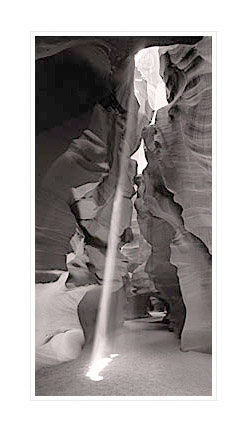
|
Black and White Portfolio
When I started photography I worked almost exclusively in black and white. Today although color represents the bulk of my work I continue to take black and white photographs or a regular basis.
My long practice with black and white taught me valuable insights in the importance played by composition and tonal values in photography. In black and white one only has shades of grey and lines to work with as one lacks the "pull" that color provides
Ansel Adams once said that "color takes advantage of the obvious." I believe he meant that color can be used as a the sole area of interest in a photograph and that composition may not even play a role in taking such a photograph. For example, a red Indian Paintbrush flower is obviously red, such a stunning red that a color photograph could not fail to convey this fact. However, if the color was removed from this photograph we may have a very boring black and white image. In his statement Adams pointed to the fact that to have color as the sole interest of a photograph will not lead to the creation of the strongest image possible.
Composition is a difficult subject. My first photography teacher, Scott Mcleay, refused to teach composition and would limit his views on the subject to the fact that "any point in the image is as important as any other point." By this he meant that it is best not to favor a particular area of the image as the focus of interest. Beginning photographers often place important elements at the center of the image thereby relegating the corners to a secondary role or leaving them devoid of interest all together. At one time I became fascinated by the "Golden Rule" which states that the most important area of the image is the lower right hand corner. During that time I routinely placed elements I wanted to emphasize in that corner resulting in photographs whose composition became quite predictable.
Edward Weston, when asked for his definition of composition, stated that "Composition is the strongest way of seeing." His definition implies that different scenes, different photographic situations call for a different compositional approach. Weston promoted flexibility in regard to composition, an approach which kept his photography fresh and interesting throughout his career.
I side along with Weston's approach to composition and I do not use formulas when I create a photograph. Instead, I follow my own feelings and compose the image in an intuitive manner while responding to the scene in front of me in an attempt to see it in the strongest manner possible.
Three Rooms Ruin

Light Shaft, Antelope Canyon
Cracked Mud, Escalante, Utah
Dune and Clouds, Monument Valley
Saguaro Squeletton, Saguaro National Park, Arizona
Mesquite Sand Dunes, Death Valley, California
Kaibito Arch, Navajoland
Handprints, Navajoland
All images Copyright © Alain Briot 2010
.
|
 |
|
|
|
|